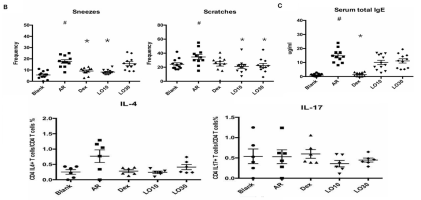Luteolin potentiates Nerve Growth Factor signalling for extra neuron regeneration / growth. so should be good in recovering from brain damage
and crosses the Blood Brain Barrier well
Luteolin Reduces Alzheimer’s Disease Pathologies Induced by Traumatic Brain Injury
 <- free form reached high ng concentrations in the brain peaking at ~ 25mg-35mg human dose. different to rat study which was much lower in blood. kept inflammation / TNF-a low.
<- free form reached high ng concentrations in the brain peaking at ~ 25mg-35mg human dose. different to rat study which was much lower in blood. kept inflammation / TNF-a low.
------
Its a potent IL-10 inducer at low doses (anti-inflammatory, low in colitis) and helps macrophages express less M1 and more M2 (more repair, less inflammation)
^ here it worked at 0.2mg/kg I.P. so even low milligram doses orally should have good effect size

oral mucosa wound healing

-------
also slows cancer growth https://aacrjournals.org/cancerres/...lin-Promotes-Degradation-in-Signal-Transducer
(not estrogenic)


 www.ncbi.nlm.nih.gov
assuming it works the same in humans, quercetin helps hair regrow substantially at "low" dose ~ 5mg
www.ncbi.nlm.nih.gov
assuming it works the same in humans, quercetin helps hair regrow substantially at "low" dose ~ 5mg

-------
2 concerns:
- Does the anti growth effect on tumors apply to healthy cells? i read about igf-1 inhibition in tumors. does it hinder muscles?
https://www.sciencedirect.com/science/article/pii/S1756464621005259#s0065 <-- no , grip strength stayed the same for luteolin fed groups. & running time increased nicely
- 1 potential problem is it chelates iron and copper. copper pretty potently. i read a study where ceruloplasmin/copper was crashed by quercetin ~250mg daily which is similar compound
^ so for long term use i wouldnt like to take more than low milligrams daily
but there is this https://file.scirp.org/pdf/PP20120400008_50818309.pdf , showing quercetin enhanced absorption from 1 big dose of minerals. quercetin is structurally similar.
(so they lower the mineral in body which enhances absorption of supplemented doses - giving a net boost if supplementing?)
theres ~5mg - 10mg per gram of dry camomile. and can be bought as supplement
Luteolin stimulates the NGF-induced neurite outgrowth in cultured PC12 cells through binding with NGF and potentiating its receptor signalingLuteolin, a flavonoid in fruits and vegetables, has neurotrophic functions without a well-characterized mechanism. Here, we hypothesize a direct interaction of luteolin with nerve growth factor (NGF); as such, the functionality of the NGF could be potentiated. The direct binding of luteolin with NGF was validated by ultra-filtration, Biacore, and docking analyses. The result supports the development of luteolin as a therapeutic, or preventive, agent for NGF insufficiency-associated neurodegenerative diseases.
and crosses the Blood Brain Barrier well
Luteolin Reduces Alzheimer’s Disease Pathologies Induced by Traumatic Brain Injury
In summary, the present study demonstrated for the first time that luteolin can abolish AD-like features after TBI in an amyloid-β depositing mouse model. short term TBI accelerates Aβ pathology in the Tg2576 mouse model of AD and luteolin pretreatment ameliorates this effect
------
Its a potent IL-10 inducer at low doses (anti-inflammatory, low in colitis) and helps macrophages express less M1 and more M2 (more repair, less inflammation)
^ here it worked at 0.2mg/kg I.P. so even low milligram doses orally should have good effect size
oral mucosa wound healing
-------
also slows cancer growth https://aacrjournals.org/cancerres/...lin-Promotes-Degradation-in-Signal-Transducer
(not estrogenic)
& tumors even shrank by the end in the luteolin fed groupsAlthough type II site ligands like luteolin do not bind to ERα or ERβ (21), they are anti-estrogenic in the rat uterus (1, 2, 7, 18). Only two genes (GTF2H2 and NCOA3) were affected by both estradiol and luteolin. Thus, the response of ESP genes to luteolin is specific and separate from genes regulated by estradiol in these cells.
-------At 4 weeks after the beginning of luteolin-containing food intake, the HAK-1B tumor volume began to decrease in a dosage-dependent manner. After 5 weeks of the dietary luteolin treatment, a significant decrease in tumor volume was found even in mice taking 50 ppm luteolin-containing food.
a potent apoptosis-inducing effect of luteolin (50 μmol/L) is shown in three hepatoma cell lines

Single-cell profiling reveals a potent role of quercetin in promoting hair regeneration
Hair loss affects millions of people at some time in their life, and safe and efficient treatments for hair loss are a significant unmet medical need. We report that topical delivery of quercetin (Que) stimulates resting hair follicles to grow with rapid ...
Luteolin should work better for reversing hair loss / regrowth assuming the same mechanism works in humans.Luteolin (MOL000006), quercetin (MOL000098), kaempferol (MOL000422), baicalein (MOL002714), and beta-carotene (MOL002773) acted on 132, 54, 55, 35 and 18 targets, respectively. And the OB values of quercetin, luteolin, kaempferol, baicalein, and beta-carotene are 46.43%, 36.16%, 41.88%, 33.52%, and 37.18%, respectively
We selected top 3 active compounds (quercetin, luteolin, kaempferol) corresponding to core targets (AKT1, TP53, JUN, CASP3 and MYC)

Exploring the Mechanisms and Molecular Targets of Taohong Siwu Decoction for the Treatment of Androgenetic Alopecia Based on Network Analysis and Molecular Docking
Taohong Siwu decoction (THSWD) is traditionally used to treat androgenic alopecia (AGA) in clinical practice of traditional Chinese medicine. This study used a network pharmacology approach to elucidate the molecular mechanism governing the effect of ...www.ncbi.nlm.nih.gov
-------
2 concerns:
- Does the anti growth effect on tumors apply to healthy cells? i read about igf-1 inhibition in tumors. does it hinder muscles?
https://www.sciencedirect.com/science/article/pii/S1756464621005259#s0065 <-- no , grip strength stayed the same for luteolin fed groups. & running time increased nicely
- 1 potential problem is it chelates iron and copper. copper pretty potently. i read a study where ceruloplasmin/copper was crashed by quercetin ~250mg daily which is similar compound
In the present study a decreased activity of Complex IV in mice treated with quercetin is clear. This is well correlated with decreased levels of ceruloplasmin
Our previous research [30] exposed that mild copper deprivation in mice is correlated with a decreased protein expression and activity of Complex IV at the level of OXPHOS supercomplexes along with a decrease in the ceruloplasmin levels.
Luteolin and quercetin possessing both (3-hydroxy)-5-hydroxy-4-keto and the catechol ring B were able to chelate 2 copper atoms per molecule similarly
^ so for long term use i wouldnt like to take more than low milligrams daily
but there is this https://file.scirp.org/pdf/PP20120400008_50818309.pdf , showing quercetin enhanced absorption from 1 big dose of minerals. quercetin is structurally similar.
(so they lower the mineral in body which enhances absorption of supplemented doses - giving a net boost if supplementing?)
theres ~5mg - 10mg per gram of dry camomile. and can be bought as supplement
Attachments
Last edited:


